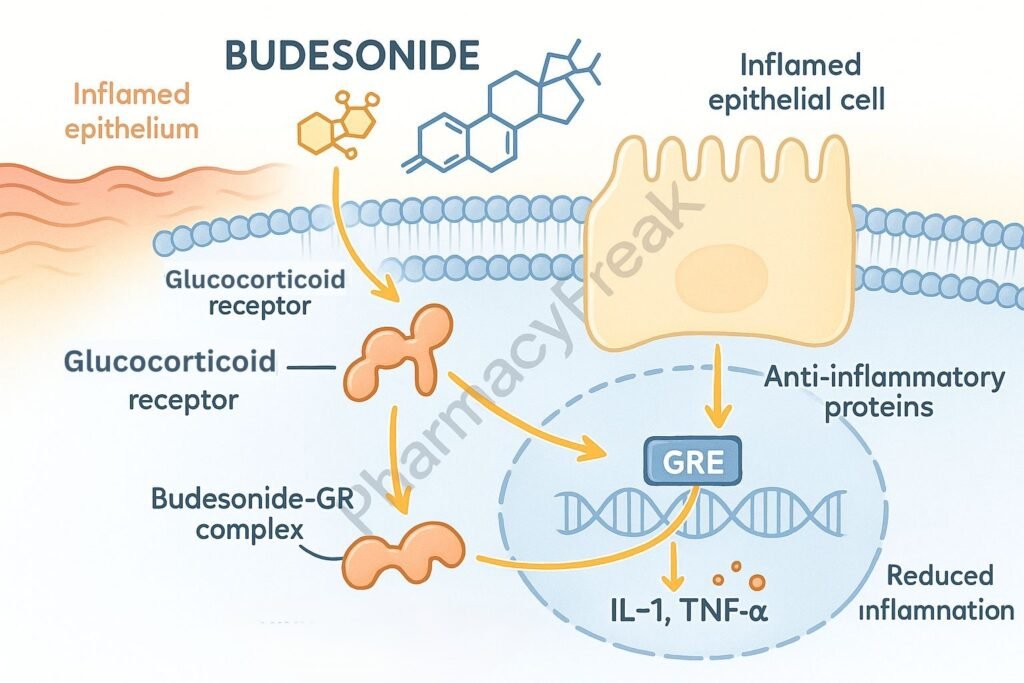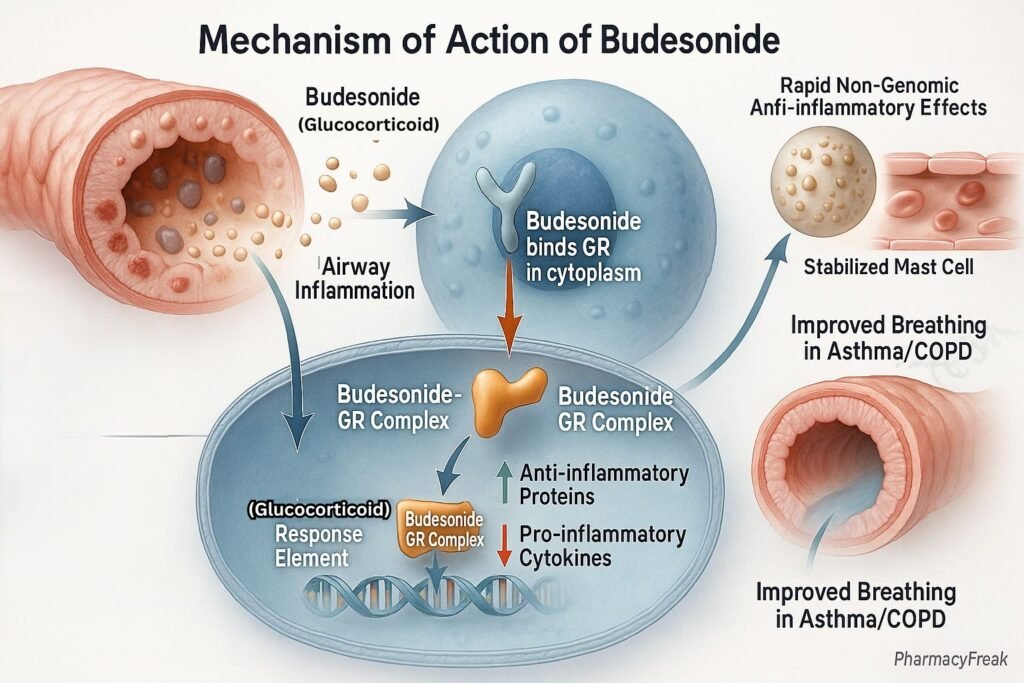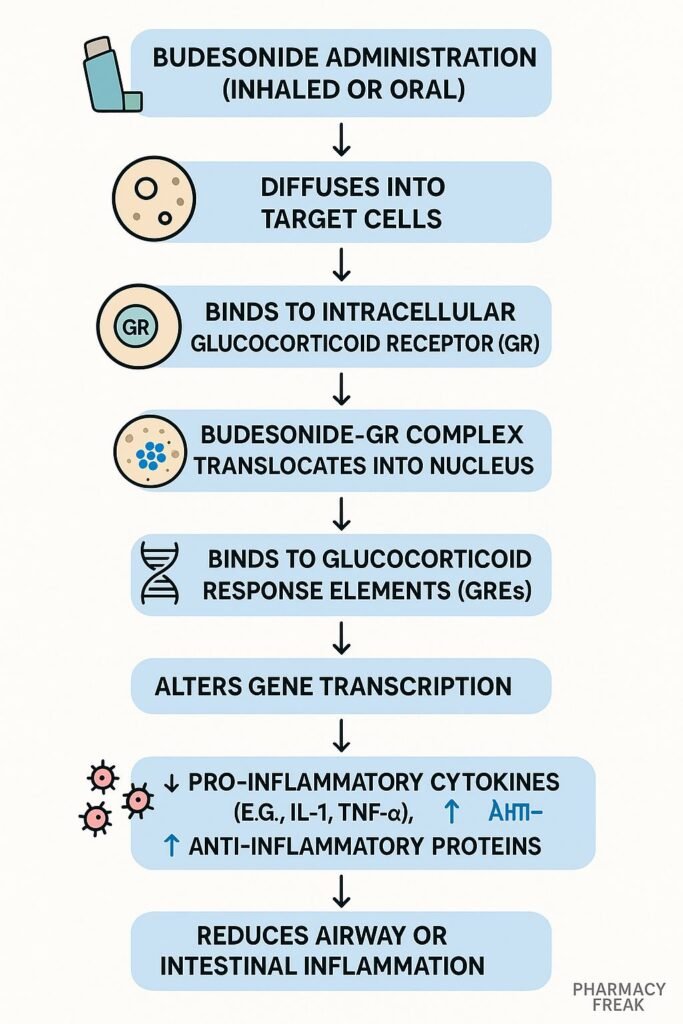Table of Contents
Introduction
Budesonide is a potent, non-halogenated glucocorticoid used primarily for its anti-inflammatory and immunosuppressive properties. It is commonly employed in the management of asthma, chronic obstructive pulmonary disease (COPD), inflammatory bowel disease (IBD), and allergic rhinitis. Budesonide’s localized activity and high first-pass metabolism reduce systemic exposure, making it a preferred option for targeted anti-inflammatory therapy.


Mechanism of Action (Step-wise)
1. Cellular Entry
Budesonide, being lipophilic, readily diffuses across cell membranes into the cytoplasm of target cells.
2. Binding to Glucocorticoid Receptors (GR)
Inside the cell, budesonide binds to cytosolic glucocorticoid receptors, forming a drug-receptor complex.
3. Translocation to the Nucleus
The budesonide-GR complex translocates to the nucleus and binds to glucocorticoid response elements (GREs) on DNA.
4. Modulation of Gene Expression
This leads to transcriptional activation of anti-inflammatory genes (e.g., lipocortin-1) and suppression of pro-inflammatory cytokines (e.g., IL-1, IL-6, TNF-α).
5. Inhibition of Inflammatory Mediators
Budesonide reduces the production of prostaglandins, leukotrienes, histamine, and other inflammatory mediators by inhibiting phospholipase A2 and COX-2.
6. Decreased Immune Cell Recruitment
It suppresses migration and activation of eosinophils, mast cells, and T-lymphocytes, resulting in decreased tissue inflammation.

Pharmacokinetics
- Route of Administration: Inhalation, oral, nasal, rectal
- Bioavailability: ~10–15% (inhaled), ~12% (oral, due to first-pass metabolism)
- Time to Peak Plasma: 30–90 minutes (inhaled)
- Half-Life: 2–3.6 hours
- Protein Binding: ~88%
- Metabolism: Hepatic (CYP3A4-mediated)
- Excretion: Primarily renal (as metabolites)
Clinical Uses
- Asthma (maintenance therapy)
- Chronic obstructive pulmonary disease (COPD)
- Allergic rhinitis (nasal spray)
- Inflammatory bowel disease (Crohn’s disease, ulcerative colitis)
- Eosinophilic esophagitis
- Microscopic colitis
Adverse Effects
- Oropharyngeal candidiasis (inhaled)
- Hoarseness of voice
- Headache
- Nausea
- Growth retardation in children (long-term use)
- Adrenal suppression (with systemic exposure)
- Contraindications: Hypersensitivity, untreated systemic fungal infections
Comparative Analysis
| Parameter | Budesonide | Fluticasone |
|---|---|---|
| Class | Inhaled corticosteroid | Inhaled corticosteroid |
| Bioavailability (Inhaled) | ~10–15% | <1% |
| First-Pass Metabolism | Extensive | Extensive |
| Duration of Action | Intermediate | Long |
| Common Use | Asthma, IBD | Asthma, COPD |
Multiple Choice Questions (MCQs)
1. Budesonide primarily acts on which receptor?
a) Mineralocorticoid receptor
b) Glucocorticoid receptor
c) Adrenergic receptor
d) Dopamine receptor
Answer: b) Glucocorticoid receptor
2. Which enzyme metabolizes budesonide?
a) CYP1A2
b) CYP2D6
c) CYP3A4
d) CYP2C9
Answer: c) CYP3A4
3. Which is a major local side effect of inhaled budesonide?
a) Rash
b) Cough
c) Oropharyngeal candidiasis
d) Tremor
Answer: c) Oropharyngeal candidiasis
4. Budesonide is useful in:
a) Myasthenia gravis
b) Epilepsy
c) Asthma
d) Parkinsonism
Answer: c) Asthma
5. Budesonide reduces inflammation by:
a) Blocking sodium channels
b) Inhibiting prostaglandin synthesis and cytokines
c) Activating NMDA receptors
d) Enhancing GABA activity
Answer: b) Inhibiting prostaglandin synthesis and cytokines
FAQs
Q1. Is budesonide a bronchodilator?
No, it is an anti-inflammatory agent, not a bronchodilator.
Q2. Can budesonide be used in pregnancy?
It is classified as Category B and is considered relatively safe when used appropriately.
Q3. Does budesonide cause systemic steroid effects?
Minimal when inhaled or used topically, but possible at high doses or prolonged use.
Q4. Is budesonide a fast-acting drug?
No, it is used for maintenance therapy, not for acute relief.
Q5. Can budesonide be used long-term?
Yes, under supervision, especially for chronic inflammatory conditions.
References
- Goodman & Gilman’s The Pharmacological Basis of Therapeutics, 12th Edition
- KD Tripathi, Essentials of Medical Pharmacology, 7th Edition
- Budesonide Prescribing Information
- Clinical treatment guidelines for asthma and IBD

I am pursuing MBA in pharmaceutical management from NIPER Hyderabad with a strong academic record and proven success in national-level pharmacy entrance exams. I secured AIR 61 in NIPER 2024 (MS/M.Pharm) and AIR 27 in NIPER MBA, along with AIR 147 in GPAT 2024 and AIR 907 in GPAT 2023. I also achieved AIR 6 in AIIMS CRE-2025 for Drug Store Keeper and was selected as a Pharmacist (AIR 61) for ESIC. Additionally, I was the Runner-Up in Round 2 of the EY Case Study Competition.
At PharmacyFreak.com, I aim to guide future pharmacists through expert content, exam strategies, and insightful resources based on real experience and academic excellence.
Mail- harsh@pharmacyfreak.com
